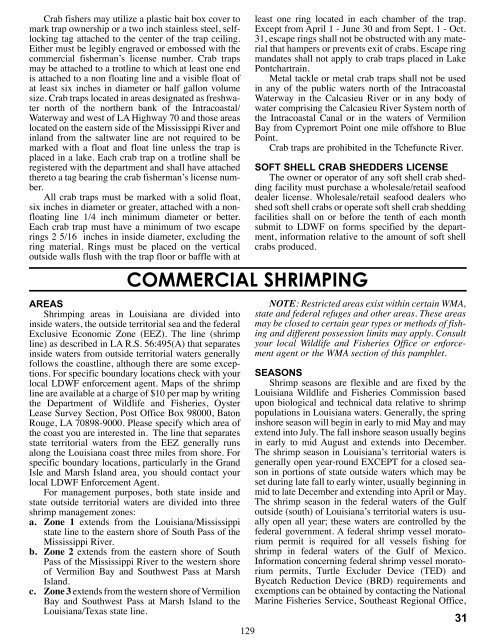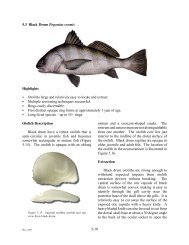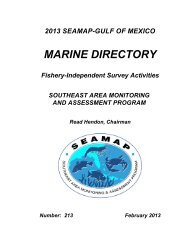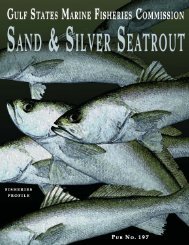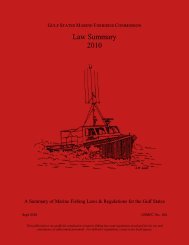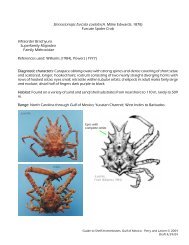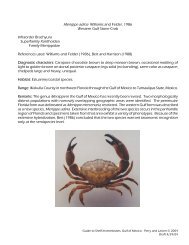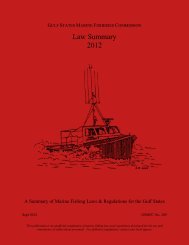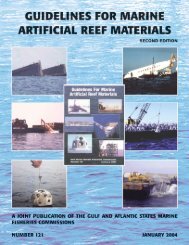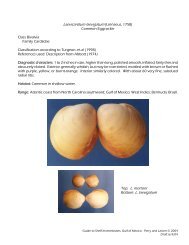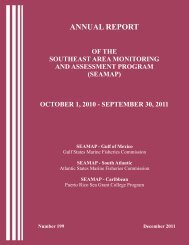Basic Commercial Fishing Regulations - Gulf States Marine ...
Basic Commercial Fishing Regulations - Gulf States Marine ...
Basic Commercial Fishing Regulations - Gulf States Marine ...
You also want an ePaper? Increase the reach of your titles
YUMPU automatically turns print PDFs into web optimized ePapers that Google loves.
Crab fishers may utilize a plastic bait box cover to<br />
mark trap ownership or a two inch stainless steel, selflocking<br />
tag attached to the center of the trap ceiling.<br />
Either must be legibly engraved or embossed with the<br />
commercial fisherman’s license number. Crab traps<br />
may be attached to a trotline to which at least one end<br />
is attached to a non floating line and a visible float of<br />
at least six inches in diameter or half gallon volume<br />
size. Crab traps located in areas designated as freshwater<br />
north of the northern bank of the Intracoastal/<br />
Waterway and west of LA Highway 70 and those areas<br />
located on the eastern side of the Mississippi River and<br />
inland from the saltwater line are not required to be<br />
marked with a float and float line unless the trap is<br />
placed in a lake. Each crab trap on a trotline shall be<br />
registered with the department and shall have attached<br />
thereto a tag bearing the crab fisherman’s license number.<br />
All crab traps must be marked with a solid float,<br />
six inches in diameter or greater, attached with a nonfloating<br />
line 1/4 inch minimum diameter or better.<br />
Each crab trap must have a minimum of two escape<br />
rings 2 5/16 inches in inside diameter, excluding the<br />
ring material. Rings must be placed on the vertical<br />
outside walls flush with the trap floor or baffle with at<br />
Areas<br />
Shrimping areas in Louisiana are divided into<br />
inside waters, the outside territorial sea and the federal<br />
Exclusive Economic Zone (EEZ). The line (shrimp<br />
line) as described in LA R.S. 56:495(A) that separates<br />
inside waters from outside territorial waters generally<br />
follows the coastline, although there are some exceptions.<br />
For specific boundary locations check with your<br />
local LDWF enforcement agent. Maps of the shrimp<br />
line are available at a charge of $10 per map by writing<br />
the Department of Wildlife and Fisheries, Oyster<br />
Lease Survey Section, Post Office Box 98000, Baton<br />
Rouge, LA 70898-9000. Please specify which area of<br />
the coast you are interested in. The line that separates<br />
state territorial waters from the EEZ generally runs<br />
along the Louisiana coast three miles from shore. For<br />
specific boundary locations, particularly in the Grand<br />
Isle and Marsh Island area, you should contact your<br />
local LDWF Enforcement Agent.<br />
For management purposes, both state inside and<br />
state outside territorial waters are divided into three<br />
shrimp management zones:<br />
a. Zone 1 extends from the Louisiana/Mississippi<br />
state line to the eastern shore of South Pass of the<br />
Mississippi River.<br />
b. Zone 2 extends from the eastern shore of South<br />
Pass of the Mississippi River to the western shore<br />
of Vermilion Bay and Southwest Pass at Marsh<br />
Island.<br />
c. Zone 3 extends from the western shore of Vermilion<br />
Bay and Southwest Pass at Marsh Island to the<br />
Louisiana/Texas state line.<br />
least one ring located in each chamber of the trap.<br />
Except from April 1 - June 30 and from Sept. 1 - Oct.<br />
31, escape rings shall not be obstructed with any material<br />
that hampers or prevents exit of crabs. Escape ring<br />
mandates shall not apply to crab traps placed in Lake<br />
Pontchartrain.<br />
Metal tackle or metal crab traps shall not be used<br />
in any of the public waters north of the Intracoastal<br />
Waterway in the Calcasieu River or in any body of<br />
water comprising the Calcasieu River System north of<br />
the Intracoastal Canal or in the waters of Vermilion<br />
Bay from Cypremort Point one mile offshore to Blue<br />
Point.<br />
Crab traps are prohibited in the Tchefuncte River.<br />
Soft Shell Crab Shedders License<br />
The owner or operator of any soft shell crab shedding<br />
facility must purchase a wholesale/retail seafood<br />
dealer license. Wholesale/retail seafood dealers who<br />
shed soft shell crabs or operate soft shell crab shedding<br />
facilities shall on or before the tenth of each month<br />
submit to LDWF on forms specified by the department,<br />
information relative to the amount of soft shell<br />
crabs produced.<br />
<strong>Commercial</strong> Shrimping<br />
129<br />
NOTE: Restricted areas exist within certain WMA,<br />
state and federal refuges and other areas. These areas<br />
may be closed to certain gear types or methods of fishing<br />
and different possession limits may apply. Consult<br />
your local Wildlife and Fisheries Office or enforcement<br />
agent or the WMA section of this pamphlet.<br />
Seasons<br />
Shrimp seasons are flexible and are fixed by the<br />
Louisiana Wildlife and Fisheries Commission based<br />
upon biological and technical data relative to shrimp<br />
populations in Louisiana waters. Generally, the spring<br />
inshore season will begin in early to mid May and may<br />
extend into July. The fall inshore season usually begins<br />
in early to mid August and extends into December.<br />
The shrimp season in Louisiana’s territorial waters is<br />
generally open year-round EXCEPT for a closed season<br />
in portions of state outside waters which may be<br />
set during late fall to early winter, usually beginning in<br />
mid to late December and extending into April or May.<br />
The shrimp season in the federal waters of the <strong>Gulf</strong><br />
outside (south) of Louisiana’s territorial waters is usually<br />
open all year; these waters are controlled by the<br />
federal government. A federal shrimp vessel moratorium<br />
permit is required for all vessels fishing for<br />
shrimp in federal waters of the <strong>Gulf</strong> of Mexico.<br />
Information concerning federal shrimp vessel moratorium<br />
permits, Turtle Excluder Device (TED) and<br />
Bycatch Reduction Device (BRD) requirements and<br />
exemptions can be obtained by contacting the National<br />
<strong>Marine</strong> Fisheries Service, Southeast Regional Office,<br />
31


